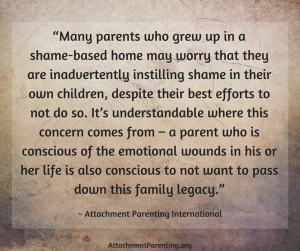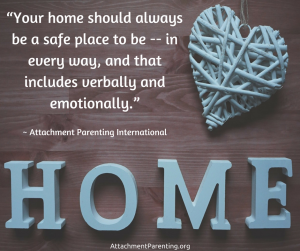Category: Parenting without Shame
Peacemaker or peacebreaker?
What about boys and Attachment Parenting?
“As a culture, we have always had different perceptions and expectations of boys. People often fear that if boys are nurtured too much, it somehow warps their personalities and makes them too dependent and too sensitive. Conventional attitudes about boys permeate all aspects of society — parents, grandparents, teachers, and coaches — and has created…a ‘boy code’: myths that boys’ behavior is driven solely by their hormones and not the environment, boys need to learn to be tough at an early age, and so on. This code has only served to force boys to become disconnected from their feelings — less sensitive and more aggressive.
New research has begun to reverse this trend by emphasizing the importance of mothers and fathers in nurturing strong emotional connections with their sons.” ~ Attached at the Heart: Eight Proven Parenting Principles for Raising Connected and Compassionate Children
by Barbara Nicholson & Lysa Parker, API’s cofounders
Learn what this new research says, which directly makes the case for Attachment Parenting of our sons. Purchase your copy through the Amazon link above to have a portion of the proceeds benefit Attachment Parenting International (API).
Home should be safe in every way
Understanding Shame, part 5: Healing emotional trauma
Editor’s note: This week, we offer you a 5-part series — originating in The Attached Family online magazine’s “Parenting Without Shame” issue — to help you better understand the development of toxic shame. Part 1 explained how trauma includes 3 components: Fear, Disconnection, and Shame. Part 2 explored Fear. Part 3 defined Disconnection. Part 4 discussed what it means to become “shame-based.” In this final Part 5, we take a look at the healing process.
One of the challenges for healing of emotional trauma is that although trauma-worlds are created in response to external events, once established, they form rigid and closed internal systems.
Locked inside these systems, our behavior sets us up to be retraumatized by other people. Additionally, the ways that we behave toward ourselves are invariably retraumatizing. Trauma-worlds are self-perpetuating.
Locked inside these systems, we also struggle to see trauma for what it is. That leaves us little choice but to focus on the visible symptoms and the chronic, deadening pain they create.
Healing Doesn’t Come Through Symptom Relief
 Symptoms of emotional trauma include the fear, disconnection, and shame that lie at the heart of a trauma-world; also depression, meaninglessness, addictions, self-harm, rage, and unexplained physical pain, and ailments. Additionally, we are likely to struggle in our relationships and to sabotage things we care about. This is why family therapy is extremely important. Once started, your therapist may recommend individual children’s therapy.
Symptoms of emotional trauma include the fear, disconnection, and shame that lie at the heart of a trauma-world; also depression, meaninglessness, addictions, self-harm, rage, and unexplained physical pain, and ailments. Additionally, we are likely to struggle in our relationships and to sabotage things we care about. This is why family therapy is extremely important. Once started, your therapist may recommend individual children’s therapy.
Focusing on such symptoms, we — as individuals and as a society — put our resources into trying to alleviate them, perhaps through short-term family therapy or psychotherapeutic drugs, or by pinning our hopes to something like success at work, a new romantic relationship, losing weight, or cosmetic surgery.
These “symptom relievers” can give us temporary respite, but it won’t free us from the internal systems that were set up in the wake of the traumatizing experiences, so in time, we fall back into our suffering.
Even when we can see beneath the symptoms to the underlying traumatizing experiences, we are unlikely to recognize the trauma-worlds in which we are living, so our first port of call is to blame whoever, or whatever, caused the original wounds and look for retribution.
That is a valuable first step and a necessary part of the process, for we do need to recognize what happened to us. We need to validate the experience and understand that it was not our fault. However, focusing on the traumatizing experience or on punishing the perpetrators is not enough by itself to bring deep healing, because that won’t change the embodied systems that form our trauma-worlds. It’s akin to being hit by a drunken driver and having our leg broken. Focusing on the accident and jailing the driver won’t heal our leg.
How Healing Happens
 Healing trauma requires the courage to recognize that ultimately our lives are compromised not by the original traumatizing experiences themselves, but by the trauma-world that is created by our own minds and bodies as a response to those experiences. And we need to recognize this reality without blaming and judging ourselves — we need to understand that creating a trauma-world is what human beings do to survive.
Healing trauma requires the courage to recognize that ultimately our lives are compromised not by the original traumatizing experiences themselves, but by the trauma-world that is created by our own minds and bodies as a response to those experiences. And we need to recognize this reality without blaming and judging ourselves — we need to understand that creating a trauma-world is what human beings do to survive.
At the same time, we have to take responsibility for our healing, and for moving out of our trauma-worlds.
Developing a cognitive awareness of the original traumatizing experiences, and of the systems created in their wake, is a good start to the process of taking responsibility for our own healing. But it is not enough.
To create lasting change, we have to enter into our emotional minds and bodies and slowly become aware of what we carry from the inside.
That means opening to the original traumatizing pain and fear, learning how to tolerate it, and integrating it into our sense of who we are. It is only when we find ways of relating to our buried pain and fear that our lives are no longer organized around the imperative to avoid anything which might trigger what we carry in our depths. However, this is an extremely challenging process: We need to do it slowly, taking one small step at a time.
Equally crucial is that we work with the fear, disconnection, and shame that form our trauma-worlds:
- First, we must enter into these systems and become conscious of how we feel in both our minds and bodies when they are active.
- Then, we have to challenge our shame, reconnect to the exiled parts of ourselves, and learn to live with our sensitized fear system.
- Finally, we need to develop new, and healthier, ways to protect ourselves.
It is hard, daunting, and arduous work. Our trauma-worlds were created to survive overwhelming pain and fear. When we try to transform them, we are besieged with the conviction that we will be annihilated. That conviction leaves us at risk of sabotaging the healing process. Thus, we need patience, perseverance, determination, and courage.
It is also imperative that we have support and guidance from those who have been through the process themselves.
Do Not Do It Alone
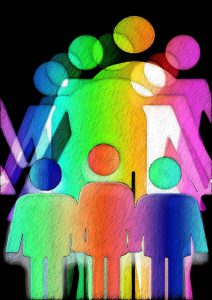 To heal trauma, we not only need an embodied consciousness of what we carry from our past, we also need new experiences. Real change happens in the present moment through lived experience.
To heal trauma, we not only need an embodied consciousness of what we carry from our past, we also need new experiences. Real change happens in the present moment through lived experience.
This need for new experiences is one of the many reasons why we can’t heal trauma alone. Emotional trauma arises because something has gone awry in our relationships, so a healing relationship is crucially important if we are to learn how to connect to other people and to ourselves in healthier ways. Similarly, we need support if we are going to approach the unprocessed pain and fear that was once unbearable, and we also need guidance if we are to transform the fearfulness, disconnection, and shame that lie at the heart of our trauma-worlds.
A healing relationship can be provided by a therapist, counselor, teacher, social worker, spiritual guide, or healing group — the label doesn’t matter. What does matter is that whoever is accompanying us has worked deeply with his or her own trauma. Healing trauma is akin to learning to speak a language like Chinese: It is not enough that our teacher has a theoretical knowledge of the grammar and that she can recognize the characters when they are written on the page; rather she must speak the language herself.
What It Means to be Healed
 When we embark on trying to heal trauma, we typically imagine that we will reach a place where our lives are free from the suffering that arises from our wounds, and where trauma no longer has any effect on our lives.
When we embark on trying to heal trauma, we typically imagine that we will reach a place where our lives are free from the suffering that arises from our wounds, and where trauma no longer has any effect on our lives.
That is not what happens. We cannot change our past. Our trauma remains part of us. What can be changed is its impact. To achieve that, we have to find new and healthier ways of being with the pain and fear embedded in the traumatizing experiences, and just as importantly, we have to transform the trauma-world that developed around them.
It is a challenging process. It takes time. Many people, and indeed most public health services, look for an easier and faster route. But there is no easy route. To address trauma in a meaningful way, we need to commit ourselves to this challenge.
I believe it is vitally important that we make this commitment — not only to help ourselves — but also because when we carry unaddressed trauma, we have no choice but to relate to our children, family, neighbors, and colleagues in ways that are likely to result in them becoming traumatized.
In contrast, when we transform our trauma-worlds, we break that spiral and start relating to ourselves, other people, and the world around us in much healthier and more nurturing ways.
Photo sources: Pixabay.com
Understanding Shame, part 4: Growing up shame-based
Editor’s note: This week, we offer you a 5-part series — originating in The Attached Family online magazine’s “Parenting Without Shame” issue — to help you better understand the development of toxic shame. Part 1 explained how trauma includes 3 components: Fear, Disconnection, and Shame. Part 2 explored Fear. Part 3 defined Disconnection. In this Part 4, we take a look at what it means to become shame-based.
Shame is a visceral and pervasive feeling of being fundamentally flawed and inadequate as a human being.
Shame is primarily relational: Although shame leaves us feeling absolutely alone, its roots lie in an implicit conviction that we are somehow unworthy of having meaningful relationships with other people.
Shame vs Guilt
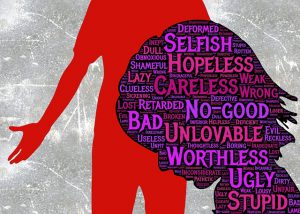 Shame is often confused with guilt, but with guilt, we feel bad about things we have done. With shame, we feel bad about who we are.
Shame is often confused with guilt, but with guilt, we feel bad about things we have done. With shame, we feel bad about who we are.
Guilt is about our actions. Shame is about our being.
Shame is mediated by the emotional networks of the brain, so although shame is typically accompanied by self-critical thoughts like “I am stupid/useless/fat/pathetic,” it is ultimately lived as an embodied experience that resides deep beneath our awareness and sucks us into the psychological equivalent of a black hole.
When Shame Becomes Toxic
Shame is a product of evolution, and it is experienced as a passing emotion in almost everybody. It exists to tell us that we are at risk of losing important social relationships, or that we might be thrown out of our group.
However, if we’ve been traumatized, then shame becomes indelibly interwoven with our implicit sense of who we are, whereupon our identity becomes “shame-based.”
There are several routes to becoming shame-based:
- Shame can originate outside of us — When we are made to feel inadequate by our family, caregivers, teachers, peers, culture, or socio-political environment, we absorb that shame and make it our own. In this case, being shamed constitutes the original painful and frightening experience around which our trauma-world is built.
- Human infants need sensitive and responsive nurturing from caregivers — When this need is not met, children develop an embodied and nonverbal sense of being inadequate. They also develop an embodied and nonverbal sense of inadequacy around their actual need for nurturing — implicitly feeling that there must be something wrong with them for having the needs.
- Shame can originate inside us as a response to more overt traumatizing experiences — Painful and frightening experiences occur that have nothing to do with being shamed. However, we have evolved a need to understand why these things have happened to us, and for various reasons, we tend to believe that we are at fault. For example, children whose parents divorce commonly feel that if they had been “better,” their parents would have stayed together.
- Once we’ve entered a trauma-world, shame can be created in response to our own behavior — There are times when we know we are over-reacting. However, because we aren’t aware that our fear system is hyper-sensitive, we take our behavior as evidence of our own supposed inadequacy. In addition, when we bury parts of ourselves in order to make ourselves acceptable to others, we implicitly sense that we are being inauthentic, which in turn creates shame.
Irrespective of how our shame originates, once we’ve become shame-based, we can’t recognize shame for what it is. Thus, we see ourselves through a distorted lens. As a result, we are likely to experience ourselves as contemptible and feel a victim to our own believed inadequacy.
What Doesn’t Work to Heal Shame
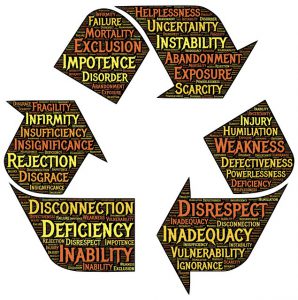 In this state, we get sucked into a downward spiral of shame. We can become even more desperate to obliterate the parts of ourselves that we believe make us inadequate, redoubling our efforts to shame those parts into submission. However, when we use shame against ourselves, we retraumatize ourselves. Then, instead of fostering change, we reinforce the status quo and fortify the walls of our trauma-world.
In this state, we get sucked into a downward spiral of shame. We can become even more desperate to obliterate the parts of ourselves that we believe make us inadequate, redoubling our efforts to shame those parts into submission. However, when we use shame against ourselves, we retraumatize ourselves. Then, instead of fostering change, we reinforce the status quo and fortify the walls of our trauma-world.
At the same time, we try to cajole ourselves into success, believing that if we can force ourselves to become more than we are — or ideally perfect — then the gnawing pain of being shame-based will abate. However, if we are shame-based, then no amount of success will be enough. No matter what we do, we are never enough.
Being shame-based doesn’t only poison our relationship with ourselves, it also poisons our relationships with others. When we are shame-based, we will be terrified that if others get to know us, they will see us as the inadequate person we believe ourselves to be. In an unconscious attempt to prevent that from happening, we may put up barriers, push people away, and sabotage relationships. Alternatively, we may try to control others, hoping that we can prevent them from doing anything that might bring our shame to the surface.
We are generally not conscious of what we are doing, or indeed why we are doing it. However, we are left with a murky feeling that our relationships lack authenticity, trust, and intimacy. As a result, we feel increasingly isolated.
Also, because human beings are such a profoundly social species, when we don’t have meaningful relationships, we feel sub-human, and that, in turn, exacerbates our shame.
In short, shame creates more shame. Shame also generates isolation and fear. And shame reinforces the need to disconnect. Ultimately, shame keeps us locked in our trauma-worlds.
Tomorrow, in Part 4, we’ll explore what does work in healing shame
Photo sources: Pixabay.com
Understanding Shame, part 3: Disconnection
Editor’s note: This week, we offer you a 5-part series — originating in The Attached Family online magazine’s “Parenting Without Shame” issue — to help you better understand the development of toxic shame. Part 1 explained how trauma includes 3 components: Fear, Disconnection, and Shame. Part 2 explored Fear. In this Part 3, we take a look at Disconnection.
Disconnection involves cutting off from some aspect of ourselves.
There are different forms that disconnection can take. All provide us with some kind of protection, but all are ultimately harmful, because they leave us cut off from our own internal reality and from the reality of the external situation.
The Original Disconnection
Disconnection first occurs during the original traumatizing experience. In the midst of a terrible situation, the release of opiates from within us blocks the pain and fear coursing through our bodies, and we are numbed to the feelings.
This is an adaptive response, because it means that if we get a chance to escape, we can take it . Escape would be impossible if we were incapacitated by pain and fear.
Unprocessed Disconnection
 Once we are out of danger, and if we have enough support, we may be able to reconnect to our pain and fear, and process them. However, without support, our unprocessed emotions remain locked away in our unconscious minds and bodies. This is because we simply can’t function if we allow overwhelming emotions into awareness.
Once we are out of danger, and if we have enough support, we may be able to reconnect to our pain and fear, and process them. However, without support, our unprocessed emotions remain locked away in our unconscious minds and bodies. This is because we simply can’t function if we allow overwhelming emotions into awareness.
There are many harmful consequences of remaining disconnected from the traumatizing pain and fear we’ve experienced:
1) We are compelled to avoid anything that might bring our unprocessed emotions into awareness. This compulsion to protect ourselves from what was once overwhelming poison in our relationships, creates a desperate need for control and prevents us from taking new opportunities. It can also lead to attempts to sabotage the healing process.
2) Having locked the overwhelming pain and fear in our bodies, we must disconnect from our bodies to prevent these feelings from surfacing. This creates new layers of suffering and difficulties:
- Bodies that carry unprocessed pain and fear can become distorted. Parts of our body may be chronically frozen, collapsed, tense, or inflamed. Our posture might be off-kilter. Our breathing shallow. We might stutter.
- We may be at risk of being drawn into addictions, both those that take us out of our bodies, and those which represent our bodies’ desperate attempts to be noticed and nurtured.
- Needing to understand why we ended up traumatized, it is all too easy to blame our alienated bodies. Thereafter we try to perfect our bodies through compulsive dieting, obsessive exercising, or an endless string of plastic surgeries. In so doing, we become further alienated from our bodies.
- We lose access not just to the original pain and fear, but to emotions more generally. Because emotions arise in the body, when we disconnect from our body, we prevent all emotions from making their way freely into our awareness. As a result, we may feel flattened, dulled, and lacking in vibrancy. Additionally, emotions evolved to guide our responses to the world, so when we can’t access this information, it is as though we have lost our compass, and the sense of danger that is already part of our trauma-worlds becomes more intense.
3) In its most extreme form, the drive to separate from the pain and fear of the original trauma can result in a dissociative identity disorder.
Disconnected Emotions
 Underlying the disconnection that I’ve just discussed is a deep fear of the unprocessed and overwhelming emotions that we experienced during the past, as part of the original trauma. There is another kind of disconnection, too — one which is underlain by fear of being attacked or abandoned in the present. This typically occurs when certain parts of ourselves are unacceptable to our family, teachers, or society. Under these circumstances, we cut off or bury the unacceptable parts in an attempt to protect ourselves from the possibility of being retraumatized.
Underlying the disconnection that I’ve just discussed is a deep fear of the unprocessed and overwhelming emotions that we experienced during the past, as part of the original trauma. There is another kind of disconnection, too — one which is underlain by fear of being attacked or abandoned in the present. This typically occurs when certain parts of ourselves are unacceptable to our family, teachers, or society. Under these circumstances, we cut off or bury the unacceptable parts in an attempt to protect ourselves from the possibility of being retraumatized.
The parts we cut off might be so-called “negative” emotions like pain, fear, or anger, but we can just as easily bury our joy, passion, vulnerability, sexuality, intellect, ambition, and creativity. We might also disconnect from our need for love and connection, or from our need for independence and self-expression.
Sometimes, we try to bury the unacceptable parts of ourselves using self-control and willpower. Other times, critical inner voices try to shame these parts into submission. Sometimes, the “unacceptable” parts are locked in our bodies, perhaps through clenching particular muscles, and by adopting a specific posture. But often this kind of disconnection occurs unconsciously — we are unaware of what we have lost.
The Results
Being cut off from parts of ourselves contributes to the underlying sense of loneliness that is inherent to trauma, because we are abandoning aspects of who we are. It also exacerbates the sense of danger that is built into a trauma-world, because we are not rooted in the fullness our own reality.
Tomorrow, in Part 4, we’ll explore the third component of trauma: Shame
Photo sources: Pixabay.com
Understanding Shame, part 2: Fear
Editor’s note: This week, we offer you a 5-part series — originating in The Attached Family online magazine’s “Parenting Without Shame” issue — to help you better understand the development of toxic shame. Part 1 explained how trauma includes 3 components: Fear, Disconnection, and Shame. In this Part 2, we take a look at Fear.
 In response to experiencing overwhelming pain or fear, biological changes occur that leave our minds and bodies extremely sensitive to potential danger.
In response to experiencing overwhelming pain or fear, biological changes occur that leave our minds and bodies extremely sensitive to potential danger.
There are many harmful consequences to having a sensitized fear system. However, if we live in a dangerous environment, suffering these consequences is the lesser of evils, because without being alert to danger, we are likely to die young. In fact, the ability of minds and bodies to become more fearful in dangerous environments is the product of evolution, and exists in many different animal species.
We are particularly alert to danger around the original traumatizing experiences. At the center of a trauma-world is the imperative to avoid retraumatization. Often, this imperative is held unconsciously, so we don’t know that it is driving us. All the same, it impacts our lives in ways that can cause as much — if not more — pain than the original wounding.
Trauma-reactions Intend to Protect, But Actually Hurt
Sometimes, it is impossible to avoid situations that appear similar to the one that traumatized us. When this happens, our old trauma comes back to life — not as a memory of the past, but as a fear-driven, knee-jerk reaction. I’ve called these “trauma-reactions.”
Trauma-reactions are generally built around the mammalian responses to danger: freeze, flight, fight, and submission — though, in each of us, they will take a unique form.
Trauma-reactions seem to come out of nowhere. That is because of the way that traumatizing events are recorded in our memories. Normally, when we commit an event to memory, a tag is added to the event recording when and where it occurred. When these memories are activated, the tags inform us that the experience happened at a particular moment in our past.
In contrast, overwhelming painful and frightening experiences are committed to memory without being tagged with a time and place. Consequently, when these memories are activated, we aren’t aware that we are remembering the past. Instead, we relive the visceral feelings and reactions of earlier experiences as if they were present reality. This kind of memory is called “implicit” or “procedural” memory.
It is easier to get a sense of implicit memory if we think about riding a bicycle: When we get on a bicycle, we don’t consciously remember learning to contract this muscle, or to lean in that direction; rather, what we learned during childhood is implicitly written into our nervous system and muscles, and that memory comes alive as a set of lived reactions.
The advantage of implicit memory is that it enables us to react almost instantaneously, and it is easy to see how that is valuable with a skill like bicycle-riding. Similarly, growing up in a dangerous environment, the ability to react virtually instantaneously can save our lives.
However, with trauma-reactions this instantaneous response can also be problematic, because the implicit memory will sometimes be activated when there is no danger. Worse, because we will be unaware that our traumatic memories have come back to life, we’ll be convinced that what we are feeling is happening right now. As a result, we are likely to behave in ways that recreate the very situation we are trying to avoid.
Protect Against Fear
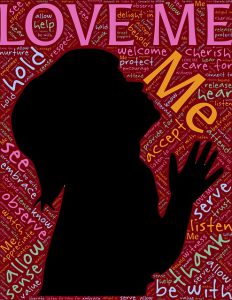 When thinking about childhood trauma, we need to be aware that throughout our evolutionary history, danger hasn’t only come from predators and illness — it has also come from parents.
When thinking about childhood trauma, we need to be aware that throughout our evolutionary history, danger hasn’t only come from predators and illness — it has also come from parents.
In fact, anthropologists now know that for our ancestors, the greatest danger faced by infants was being abandoned to die by a mother who didn’t have the resources to care for another child. It could be that the mother already had a nursing child, or she might be lacking in social support, or there could be a famine.
Either way, for ancestral human infants, an inattentive mother would have been implicitly terrifying, because it would have indicated that the infant’s life was at risk.
Tomorrow, in Part 3, we’ll explore the second component of trauma: Disconnection
Photo sources: Pixabay.com

